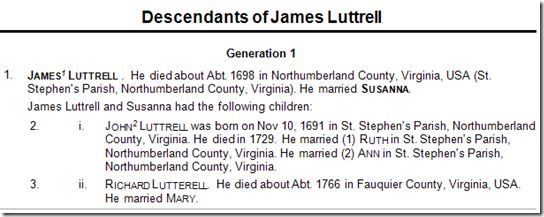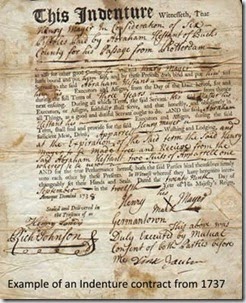James Loterell, Lotterell, Luttrell, Littrell, Captain William Piper, Captain Robinson
Our first proven ancestor to America was James Luttrell, LOTERILL, LITTRELL who was transported to Northumberland County, Virginia in 1671. Since that time the name has been found in recordings spelled several various ways, i.e. LITREL(L), LITTREAL, LUTRAL, LUTERAL, LUTREALL, LUTTERAL, LUTTREALL, LITTRELL, LOTERILL. In fact, the surname in the final estate settlement proceedings of James LOTERILL in Northumber1and County, Virginia is spelled "LITTRELL" and. "LUTTRELL".
James Luttrell died in 1698. Court held 15 July 1698 in Northumberland County, Virginia and 20 July 1698, shows the intestate proceedings of James Luttrell's estate in 1698, adm. by his wife, Susannah. A Parish record indicates that after Susannah's death [c.1707] a guardian is appointed for one of her sons [John, apparently not of age]. The guardian's named is John Tullous. Northumberland County, Virginia, Order Book 1678-98, page 827: Court held 15 July 1698 and Order Book 1678-98, page 828: Court held 20 July 1698. Which shows the intestate proceedings of James Luttrell's estate in 1698, adm. by his wife, Susannah.
Many have speculated on the connection between the Luttrell’s and John Tullous, but in spite of some conclusions put forth by some there is no evidence defining or establishing that relationship.
For decades the children of James and Susannah have been identified as: Richard, James, John, and Thomas. Thomas is identified as the Warden in St. Ann's Parish in Maryland, but the evidence has not survived the original claim.
Researchers have always identified James as the indentured servant James Loterell, who arrived in Maryland in 1677 on Captain William Piper's ship [1 of 17], as the father of Richard and three brothers. Our line of the family has always been identified as descending from James’s son Richard. After his arrival it isn’t until the probate papers for James in 1698 that we find our James Luttrell, AKA James Loterell, 21 years later. The probate papers of James has him as 'a land owner and Tobacco planter' in Northumberland Co., Virginia [not a great distance from Maryland].
There is, however, a problem with the identification of James Luttrell as the immigrant aboard William Piper’s ship and that is the discovery of another James Luttrell. Six years earlier another James Luttrell, AKA James Latterell, arrived in America as an indentured servant aboard Captain Laurance Robinson’s ship.
So with that in mind lets examine which one is most likely to be the land owner and Tobacco planter' in Northumberland Co., Virginia who died in 1698.
| 1677 Captain Piper’s James Loterill: the Maryland James [#5198] Previously believed to be the Tobacco Planter. What has been overlooked is that Captain Piper delivered his 'cargo' to the shores of Maryland, but in order for him to receive his bounty land he was supposed to deliver them to Virginia. He subsequently sold his rights to the cargo to a Captain Walker. This transpired in 1677, but what did Captain Walker do with his new Bond Servants?. In order for the James on Captain Piper's ship to be the Northumberland James he would have had only 21 years to complete his term as an indentured servant (usually seven years barring any penalties), raise capital and purchase land, and rise to the level of 'a land owner and Tobacco planter'. Such a rise would have had to occur in 14 years following his servitude, not an impossible task, but likely? | 1671 Captain Robinson's James Latterell: the Virginia James [#5222] James arrived as 1 of 27 indentured servants aboard the ship of Captain Laurance Robinson’s ship in 1671. Captain Robinson delivered his cargo to Northumberland, Virginia and received payment [1350 acres] for his cargo on March 23, 1671. This earlier arrival date gives him an additional 7 years to obtain his freedom and establish his position. In the absence of contrary evidence it appears that the James Latterell who arrived in 1671 is most probably our James Luttrell (m. Susannah), who died in Virginia in 1698. |
With a James Luttrell in Maryland and our James Luttrell in Virginia what do we make of the previous identification of the 4 brothers: James, John, Thomas, and Richard? We know that our James had at least two sons, John and Richard. We have no evidence that there were not also two other sons James and Thomas, but we assume that the Thomas in Maryland is the son of the Maryland James Luttrell.
Thomas's position would seem indicate that his father James remained in Maryland. This indication could be wrong, Thomas could have returned to Maryland as a young adult and eventually obtained his position, but the more probable conclusion is that he was born and raised in Maryland.
Did the Maryland James Luttrell have other sons besides Thomas? We don’t know because we don’t know to what degree the two immigrants were mingled into one person. We do find other Luttrell’s in Maryland but have not identified their connections as we know our ancestor, Richard Luttrell, is a Virginian. What became of the Maryland James is speculative at this point.
A more probable scenario would be that the James Latterell [#5222] arriving as 1 of 27 indentured servants aboard the ship of Capt. Laurance Robinson in 1671 is the Northumberland County, Virginia James Luttrell. Capt. Robinson received payment [1350 acres] for his cargo on 3-23-1671. The delivery point of this 'cargo' and earlier arrival date makes it more likely that this is the Northumberland James Luttrell [& Susannah]:
more on James Luttrell and Captain Robinson.
Robinson, Laurance. Publication 23 March 1671/1672. Location:
Northumberland County.
Description: 1350 acres on a fresh water branch of Muddy Creek, adjoining the land of Griffin Savage &c. Source: Land Office Patents No. 6, 1666-1679 (pt.1 & 2 p.1-692), p. 390 (Reel 6).



